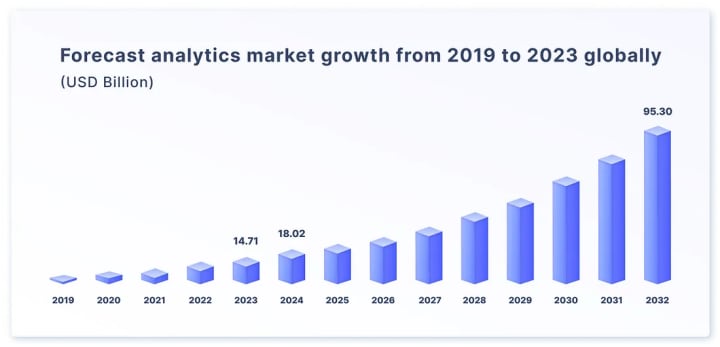Predictive Analytics: What It Is and How It Works
Predictive Analytics: Definition, Where Used & How Works

In today’s rapidly changing business world, it’s crucial for businesses to look ahead and plan for the future. This is necessary to maintain stability, plan resource utilization, and develop growth strategies. Nowadays, companies turn to technology for “predicting the future,” specifically to predictive analytics tools.
At the core of the method lies the use of big data and complex IT systems. Predictive analytics is essential for decision-making leading to increased operational efficiency, sales, and other business improvements.
In 2023, the predictive analytics market reached $14.71 billion, and by 2032, this figure is projected to grow to $95 billion. Software for predicting future events based on data is being implemented in various business sectors and is becoming part of our daily lives.

In the article, we’ll discuss what predictive analytics is, its benefits, and how this information analysis direction works.
What is predictive analytics
Predictive analytics is the creation of forecasts of future events in business through working with existing (historical) data using statistical, mathematical, and machine learning methods. As a result, the company obtains estimates of probabilities that may occur and impact the business.
Forecasting is a branch of data analytics. There are also descriptive, diagnostic, and prescriptive types of working with information.
Predictive analytics began to take shape in the 1940s during World War II. British mathematician Alan Turing and his team attempted to crack the German Enigma cipher machine. The algorithm changed daily, complicating the process, and it was necessary to “predict” the principles behind these changes. In the end, Turing managed to guess the commonality in the new combinations. It turned out to be a recurring phrase, through which they deciphered the principle of operation.
Later, IT technologies were incorporated into predictive analytics. Initially, the field where such algorithms were used was limited to financial departments. However, with the development of tools and changes in company needs, Big Data analytics became available to other business areas and employee categories. It began to play a role in decision-making for line managers and top executives. Now, not only historical data but also real-time information is used. This increases the efficiency and speed of forecasts.
Methods of predictive analytics
Popular methods of predictive analytics include:
Regression — assessing the relationship between variables and the influence of one on another. It is used when processing large data sets. For example, this method determines how changes in price will affect sales.
Decision trees — classifying data based on specified variables. It is applied to predict what decision a person will make. The name is explained by the type of model, which resembles a tree. A branch represents a possible choice, and the leaves indicate the results.
Neural networks — a machine learning-based model used for tasks involving complex interactions. Neural networks are useful in situations where there are no specific formulas for processing data.

Benefits of predictive analytics for business
Making objective and accurate decisions based on data instead of relying on the experience of managers and guesswork. This reduces risks and avoids unnecessary resource expenditures on incorrect actions. For example, predictive analytics is needed for dynamic pricing.
Maintaining competitiveness in the market. The more information you obtain about future events, the better prepared you will be for changes. Then your offerings will be more precise than those of competitors.
Increasing profits. Forecasting indicates changes in demand, delivery times for goods, and can even predict when equipment essential for business operations will fail. Knowing the “future” helps the company adapt to the situation, hedge risks, and continue operating efficiently. Thus, the business will maintain and even increase its income by increasing LTV (customer lifetime value), as forecasting contributes to retaining customers longer through targeted marketing communications.
What industries use predictive analytics

Risks in predictive analytics
Despite significant advantages, predictive analytics is not a panacea.
- Firstly, there is always a risk that even the most advanced algorithm will make mistakes. Therefore, it is not advisable to fully rely on forecasts.
- Secondly, predictive analytics may not consider all factors if there is insufficient data for analysis or if the data turns out to be inaccurate.
- Thirdly, the emergence of a “black swan” event in the future is not excluded, rendering all forecasts unreliable. This is an unexpected and previously unknown factor. For example, the COVID-19 pandemic in 2020 turned out to be such an event for many business sectors, necessitating urgent process adjustments.
Predictive analytics streamlines business operations, but currently, this method cannot fully bear the responsibility for business decisions.
How predictive analytics works
Predictive analysis relies on large volumes of data. Machine learning algorithms and complex algorithms are applied to process the information.
The stages of data analysis for forecasting include:
- Goal definition: A specific business task is set that needs to be solved with data-driven predictions. For example, “determine the demand for product N in the future year.”
- Selection of forecasting methods that will lead to the goal. It is important to identify the correct sources and types of data.
- Data collection: Information from various sources is integrated into a single system (e.g., CDP). The specific data to collect depends on the sphere of analysis and project goals. For example, marketing channels provide information about user actions on the website, completed conversions, gender data, and so on. It is important that large volumes of data are required for accurate forecasting.
- Information processing, including data cleansing. At this stage, unreliable and incomplete data are removed. This is usually a lengthy but crucial process that affects the accuracy of forecasts.
- Model building and validation: Analysis parameters are set, based on which artificial intelligence provides forecasts. Model parameters may be adjusted as needed.
- Result retrieval and implementation: Based on the forecasts, customers (who may be managers) make strategic and other decisions.
Summary
Predictive analytics is a data-driven approach where future events are forecasted based on past information. This method improves business metrics as managers make informed decisions, leading to increased profitability and market competitiveness.
Machine learning and methods such as regression, decision tree, and neural networks are utilized in predictive analytics. This approach is applied across various sectors including sales, marketing, finance, manufacturing, healthcare, human resources management, and logistics.
To make forecasts, goals are set, data is collected and processed, and predictive models are built. As a result, clients receive scenarios of future developments and make business decisions accordingly.
The article was originally published here.
About the Creator
Altcraft
Interesting and useful articles about marketing, our product and online communications
Enjoyed the story? Support the Creator.
Subscribe for free to receive all their stories in your feed. You could also pledge your support or give them a one-off tip, letting them know you appreciate their work.






Comments
There are no comments for this story
Be the first to respond and start the conversation.